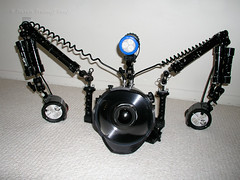BGF
Guest
BC for buoyancy, ds for anti squeeze, valve turned 1-2 turns closed. I like the arm pumping move described by cldwdiver. Never had a problem venting but that would help push it out faster if needed
Welcome to ScubaBoard, the world's largest scuba diving community. Registration is not required to read the forums, but we encourage you to join. Joining has its benefits and enables you to participate in the discussions.
Benefits of registering include
Where is option 3? Leave the drysuit valve open (or mostly open) the entire dive, and let it vent itself on ascent?
Maintaining buoyancy with the drysuit is asking for trouble. One day you'll blow the ascent, and there will be no stopping it.
But, it's your life. You choose.
* Do not push the valve button. It will usually let a little water in. Adjust how open the valve is for ease of venting. Roll your valve-side shoulder up, lift your arm toward the surface, allow air into it, then flex your arm to pump the air out the valve. Repeat as needed. Sometimes you need to raise your torso to get air up into your arm.
Rob, I seem to be in the minority, but I do what you do. I use my drysuit for both buoyancy and warmth. Here is question I have never had answered from those that use the BC for buoyancy. If you have to put air in the BC during the dive to maintain neutral buoyancy, why don't you take some weight off of your weight belt until your BC is empty? Another way of putting this is that the amount of air needed to puff up the drysuit insulation should be all the air you need to maintain neutral buoyancy. If not, you are carrying too much lead.
In my opinion, the only reason to use the BC to is compensate for the weight change in the tank during the dive. For a single tank recreational dive, this is only 5lbs. The amount of air needed to compensate this is about 2l. When distributed over the entire drysuit volume, this makes a relatively trivial change to its inflation. The story is different if you are doing technical diving and are carrying a lot more air. If diving twin 130s, you are carrying 20lbs of air. Using your drysuit to add an extra 20lb of lift would seriously overinflate the suit. Using the BC would be a much better idea. Even in this case though, the goal should be to end the dive at 15ft with a correctly inflated drysuit and no air in the BC.
As far as the vent is concerned I adjust the tension during the dive. I leave it mostly open, but close it partially when I am at depth to avoid unintentional venting. When I am ready to ascend I open it all the way. On the surface I inflate the BC. I also close the vent all the way and add a little air to keep warm while swimming back to boat. I never push the vent button except when burping the suit before the dive.
To be neutral at the end of your dive you need to be negative by the weight of your gas otherwise you can't hold your stops.
Try making your camera less negative. I use capped PVC pipes as floats. Some people various closed cell foams. You don't want your camera to change your overall buoyancy. Besides, it is much easier to operate if it is near neutral. Sorry about the thread hijack.My camera is really negative, but I don't drop any weight just in case I drop the thing. This means I dive on the heavy side. I would not want to dive with all that air in my Drysuit on a regular baisis.

From what I have experienced with mine, and from what I can see others doing :1) Take the squeeze off with the dry suit and mainatain bouyancy with the BCD.
2) Use the Dry Suit for all bouyancy control. Close the Dry suit valve at the surface and open it only when ascending. On Ascent control venting by lowering and rasing you arm (i.e. the vent valve).
